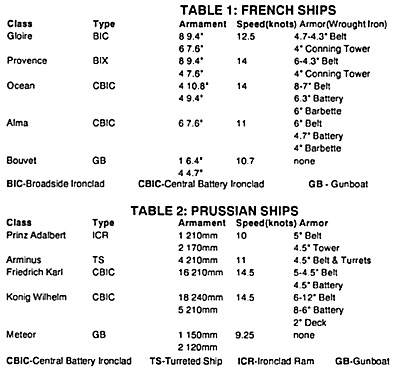
When war broke out on July 15th the French navy's plan, like their army's, was to carry the war to the Prussians. An expeditionary force of 40,000 sailors and naval infantry under General Bouraki was to land on the North Sea coast of Schleswig-Holstein. It was hoped that a successful landing would bring Denmark with its army and ports into the war on France's side.
At the outbreak of hostilities most of the active fleet was in the Mediterranean and on colonial stations. The Channel squadron only had three ships: Flandre and Gauloise, both Provence class ironclads, and Thetis an Alma class (see Table 1). The ships in the Mediterranean had to stay there and convoy the Algerian units across to Europe. In the Channel ports the work of collecting the troops and transports for the landing in Germany was going very slowly.
The Prussian Navy started the war with most of its ironclads in the English Channel. They had just stopped in England before starting their summer cruise. The ships were Konig Wilhelm (flag), Friedrich Karl, Kronprinz, and Prinz Adalbert (see Table 2). While in England Friedrich Karl had to replace a screw that had fallen off. At this point the Prussians had an advantage over the weak French Channel squadron and had a good chance of winning in a fight. The Prussian admiral chose to preserve the fleet and returned to Wilhelmshaven. This decision is more sensible in light of the fact that Friedrich Karl with the temporary screw and Konig Wilhelm with a foul bottom were both slowed down and would not have been able to evade a large French Squadron. The French did not know about the return of the Prussian fleet to port for almost two weeks and much of their effort was diverted to protecting the vital troop convoys from Africa.
The first actions in European waters did not take place until the 24th of July when a strong French fleet under Vice-Admiral Bouet Willaumez was sent to observe the German coast and attack the Prussian fleet if it was at sea. This fleet was made up of four of the Provence class battleships Flandre, Gauloise, Guyenne, and Serveillante (flag); two Alma class cruisers Jean d'Arc and Thetis; and the battleship Ocean. The French observed the naval harbors of Wilhelmshaven and Kiel but were unable to do anything to the Prussian warships because of the harbor defenses. They then began a blockade of the German coast that did capture eighty ships and drive away others, but was unable to prevent the small coastal traders in the Baltic from moving just about at will. Even this imperfect blockade was not a major problem for the Prussian war effort since many imports came by land. The Prussian navy even was able to move the Arminius from Kiel to the Elbe, this required sailing around Denmark since Kiel Canal did not exist yet.
The blockade was a strain on the French sailors since they had to coal and resupply at sea. The Danish bases that they had counted on using were not made available, since by this point in the war the Prussian armies were beginning their drive into France. As the land war went against the French pressure mounted for the navy to do something. Eventually orders were received to bombard a German city or town. The French fleet, noww inn he Baltic, was unable to approach most of the German coast because of it deep draft. Most of the important commercial or naval ports were not right on the coast but were up inlets or rivers. The only town that the French would have been able to safely bombard was the small resort town of Kolberg. Luckily for the reputation of the French navy the orders were cancelled; as an open, or defenseless, town an attack on Kolberg would not only have been against international law, but also pointless.
The ironclads were soon recalled from the Baltic and replaced by smaller gunboats and frigates. Many of the fleets ironclads were partially disarmed and the guns and crews sent to the front. At the end of the war the ironclads were taking turns to blockade the French Channel ports to prevent the Prussians from taking away captured naval stores.
More The Franco-Prussian War at Sea
Back to Table of Contents -- Courier #57
To Courier List of Issues
To MagWeb Master Magazine List
© Copyright 1992 by The Courier Publishing Company.
This article appears in MagWeb (Magazine Web) on the Internet World Wide Web.
Other military history articles and gaming articles are available at http://www.magweb.com